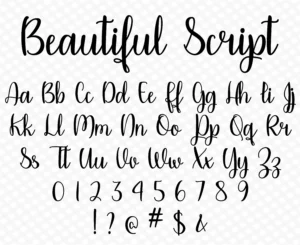The Fascinating World of Fonts: The Art and Science of Typography

Fonts are far more than merely letters on a page—they are powerful design elements that convey personality, set moods, and transform plain text into engaging communication. From ancient scripts etched on stone to the digital typefaces that define modern interfaces, fonts shape the way we perceive and interact with information every day.
A Brief History of Fonts
The evolution of fonts mirrors the development of human communication. Early writing systems, such as cuneiform and hieroglyphics, laid the groundwork for representing language visually. With the advent of the printing press in the 15th century, movable type revolutionized the spread of knowledge. Pioneers like Johannes Gutenberg introduced typefaces that balanced readability and artistry. As technology advanced, so did typography, with innovations in digital design empowering typographers to craft fonts that blend historical elegance with modern versatility.
Understanding Font Classifications
Fonts come in a variety of styles, each carrying its own aesthetic and functional qualities. Some of the key categories include:
- Serif Fonts: Characterized by small decorative strokes at the ends of letters, serif fonts (like Times New Roman, Garamond, and Georgia) are traditionally associated with print media. They often evoke a sense of reliability and formality, which is why they are commonly used in books, newspapers, and academic publications.
- Sans-Serif Fonts: Without the embellishments of serifs, sans-serif fonts (such as Helvetica, Arial, and Calibri) offer a clean, modern look. Their simplicity enhances legibility on digital screens, making them a popular choice for websites and user interfaces.
- Script Fonts: Mimicking the fluidity of handwriting, script fonts add a personal, elegant, or artistic touch to designs. They are often used in invitations, logos, and decorative headlines, though they should be used sparingly to maintain readability.
- Display Fonts: These are highly stylized and unique fonts designed to capture attention. Display fonts are ideal for headlines, posters, and packaging but are less suitable for large blocks of text due to their elaborate design and lower readability at small sizes.
- Monospaced Fonts: In monospaced fonts (like Courier and Consolas), each character occupies the same amount of horizontal space. Originally used for typewriters, these fonts are now favored in coding environments and design contexts where uniformity is paramount.
The Role of Fonts in Modern Design
Fonts are not chosen arbitrarily—they carry psychological and cultural connotations that can influence the effectiveness of a message. Here are a few key considerations when selecting fonts for various projects:
- Readability and Legibility: The primary function of text is to communicate. Whether in a novel, a website, or a business logo, choosing a font that is easy to read is essential. Designers often test typefaces at different sizes and weights to ensure that text remains clear under various conditions.
- Tone and Mood: A well-chosen font can instantly evoke a specific mood or tone. For instance, elegant serif fonts might convey tradition and authority, while playful handwritten styles can create a sense of whimsy and casual friendliness.
- Brand Identity: For businesses, fonts are critical in establishing a visual identity. A consistent typeface across marketing materials helps build brand recognition and communicates the values and personality of the company. Iconic brands are often associated with distinctive fonts that tell part of their story.
- Accessibility: Ensuring that fonts are accessible to all readers is a growing concern in modern design. This means opting for typefaces that not only look good but also provide clear contrast and simplicity, aiding those with visual impairments.
Fonts in the Digital Age
In today’s era of screens and mobile devices, the art of typography has moved beyond paper. Responsive design and high-resolution displays demand fonts that perform well across different platforms. Web-safe fonts and scalable vector graphics ensure that text retains its clarity and impact, regardless of device or resolution. Additionally, services like Google Fonts and Adobe Fonts make it easier than ever for designers to integrate diverse typefaces into websites and apps, broadening the creative possibilities.
Innovations and the Future of Typography
As technology continues to advance, so too does the potential for font design. Variable fonts, for instance, allow a single typeface to adjust its weight, width, and slant dynamically, offering unprecedented flexibility for responsive design. This innovation not only streamlines the loading of web fonts but also enhances creative expression by providing a continuous range of typographic possibilities.
Moreover, the fusion of artificial intelligence and typography is beginning to influence font creation. AI-powered tools can analyze language patterns, cultural trends, and aesthetic preferences to generate new typefaces that resonate with contemporary audiences.
Conclusion
Fonts are a captivating blend of art and science, deeply interwoven with our daily lives. From their historical roots to the cutting-edge innovations of today, fonts continue to evolve, shaping the way we communicate and express ideas. Whether you’re a designer, a writer, or simply someone who appreciates beautiful design, the world of fonts offers endless avenues for exploration and inspiration.
Comments are closed